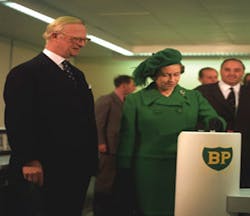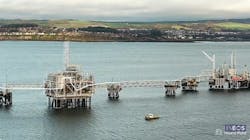INEOS celebrates 50-year anniversary of the Forties Pipeline System
INEOS has announced the 50th anniversary of the Forties Pipeline System (FPS), a piece of British engineering that the company says “has quietly powered” the nation’s economy for half a century.
Officially opened by Her Majesty Queen Elizabeth II on Nov. 3, 1975, the Forties Pipeline transformed the UK’s energy landscape. The pipeline system, INEOS noted, “took Britain from being almost entirely dependent on imported oil to becoming self-sufficient, fueling homes, transport, and industry for generations.”
Since then, the FPS has safely transported over 9.6 billion barrels of oil and gas liquids from more than 80 North Sea fields to the Kinneil Terminal at Grangemouth. The offshore portion of the FPS now runs about 235 miles in length, including trunklines and gathering lines, to connect these fields to onshore markets.
INEOS further commented: “Today, FPS remains one of Britain’s most strategically important energy assets. It is designated as Critical National Infrastructure, supporting tens of thousands of jobs across Scotland and the wider UK, and providing the lifeblood for domestic manufacturing and historically, refining at Grangemouth.”
INEOS also commented on the larger UK North Sea E&P play: “Over the last 50 years, the UK’s North Sea oil and gas industry has contributed about half a trillion pounds in taxes to the UK Treasury, but the current unfathomable government tax policy on energy is self-harming this abundant and essential energy resource. Under the Energy Profits Levy (EPL), tax rates on energy have climbed to 78%, investments are at an all-time low, and the UK is becoming increasingly reliant on expensive imports. British politicians have placed their faith in global markets, declaring that oil and gas trade on international markets and so imports will always be available from somewhere.”
“However, as the Treasury is discovering, the taxes from those oil and gas molecules will no longer be arriving in the Exchequer. And an increasing proportion of the billions of pounds paid out by UK consumers in annual energy bills will be flowing out of the country to support rival economies.”
Since acquiring the system in 2017, INEOS says that it has invested more than £500 million to modernize, secure, and extend its life well into the 2040s and beyond. “This investment ensures that the UK retains a strong and resilient energy network, capable of serving the economy for decades to come,” the company’s statement said. “However, an urgent change of government policy is required to ensure [that] this can be delivered.”
“The Forties Pipeline is a national treasure,” said Andrew Gardner, CEO INEOS FPS. “For fifty years it has quietly done its job, safely, reliably, and efficiently, carrying the oil and gas that keeps the UK moving. We should never underestimate the value of home-grown energy. North Sea oil and gas have created enormous prosperity for Britain, and they will remain essential long beyond 2050. Even as we transition to cleaner forms of energy, we will still need reliable domestic supply to power industry, transport, and homes. The Forties Pipeline has served this country for half a century, and with continued investment and good policy, it will continue to do so for generations to come.”
Forties pipeline history
The Forties oil field is the UK’s first major offshore oilfield, and it is the second-largest oil field in the North Sea after the Clair oilfield. It was discovered in 1970 and first produced oil in 1975 under ownership of British Petroleum (later BP).
Today, the Forties Pipeline System runs some 365 miles, onshore and offshore, moving production from 85 fields in the North Sea and several Norwegian fields on behalf of around 40 companies. The system has a capacity of 575,000 barrels of oil per day. It enables 29% of the UK’s oil and 30% of its gas to reach customers and is expected to run into the mid-2040s, at least.
The main trunkline of the Forties Pipeline System consists of a 36-inch pipeline originating at APA Corporation’s Forties Charlie platform. The pipeline carries crude oil 169 kilometers (105 mi), routing through the Forties Unity riser platform to the terminal at Cruden Bay. From there, unstabilized crude is co-mingled with natural gas condensate from the St Fergus terminal and pumped to the processing facility at Kinneil, Grangemouth. The onshore pipeline has three intermediate pumping stations at Netherley, Brechin, and Balbeggie.
The original 32-in. pipeline was placed in service in 1975. The Forties Unity installation was installed in 1992, and included new 36-in. pipelines. The 32-in. pipeline was abandoned in situ.
BP sold the Forties oil field to APA Corporation (then Apache Corp.) in 2003, but retained ownership of the Forties pipeline system. In April 2017, BP agreed to sell the pipeline to INEOS for a $125-million upfront payment and an additional $125 million in possible earnouts over seven years.
Since acquiring the system in 2017, INEOS has invested more than £500 million to modernize and extend its life well into the 2040s, securing one of the UK’s most critical pieces of national infrastructure.
About the Author
Bruce Beaubouef
Managing Editor
Bruce Beaubouef is Managing Editor for Offshore magazine. In that capacity, he plans and oversees content for the magazine; writes features on technologies and trends for the magazine; writes news updates for the website; creates and moderates topical webinars; and creates videos that focus on offshore oil and gas and renewable energies. Beaubouef has been in the oil and gas trade media for 25 years, starting out as Editor of Hart’s Pipeline Digest in 1998. From there, he went on to serve as Associate Editor for Pipe Line and Gas Industry for Gulf Publishing for four years before rejoining Hart Publications as Editor of PipeLine and Gas Technology in 2003. He joined Offshore magazine as Managing Editor in 2010, at that time owned by PennWell Corp. Beaubouef earned his Ph.D. at the University of Houston in 1997, and his dissertation was published in book form by Texas A&M University Press in September 2007 as The Strategic Petroleum Reserve: U.S. Energy Security and Oil Politics, 1975-2005.



